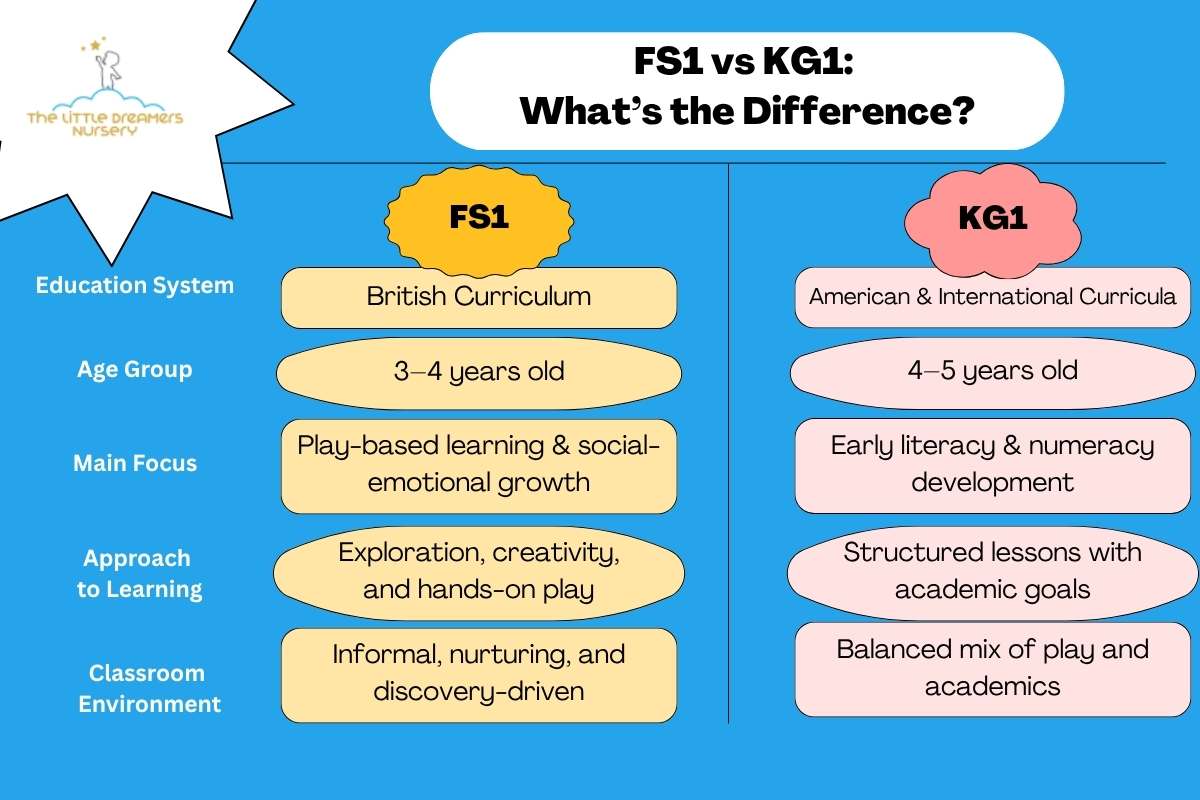If you’ve ever wondered what is the difference between FS1 and KG1, you’re not alone. These early education terms often confuse parents trying to choose the best starting point for their child’s learning journey. FS1 (Foundation Stage 1) and KG1 (Kindergarten 1) may sound similar, but they actually represent different stages in preschool education—especially between British and international school systems.
 What is fs1 and kg1?
What is fs1 and kg1?
First, let’s clarify the meaning of FS1. what does fs1 stand for in school? FS1 stands for Foundation Stage 1, which is a term commonly used in the British education system and some international curricula. In the United Kingdom, the Foundation Stage covers children aged 3-5 and focuses on play-based learning and early social and emotional development. On the other hand, FS2, or Foundation Stage 2, is the next stage in the British education system. fs2 meaning emphasize play-based learning while introducing more structured activities and preparing children for the transition to primary school.
On the other hand, KG1 stands for Kindergarten 1, which is the first year of formal schooling in many American and international curricula. KG1 typically targets children around 4-5 years old and is designed to introduce basic literacy and numeracy skills.
read more: Tips for Preparing Your Child for FS1 Nursery in Dubai
 Important differences between fs1 and kg1
Important differences between fs1 and kg1
Now that we understand what FS1 and KG1 stand for, let’s explore the key differences between the two:
-
Approach to Learning
FS1 emphasizes play-based exploration and learning. Children engage in activities that foster creativity, social interaction, and language acquisition. It is a child-centered approach that encourages hands-on experiences and imaginative play.
Read more: Foundation Stage 1
KG1, on the other hand, leans more towards structured learning. The focus is on introducing basic literacy and numeracy skills through activities such as letter recognition, phonics, and counting exercises.
-
Emphasis on curricula
FS1 places a strong emphasis on social and emotional development. Children learn to express themselves, collaborate with others, and develop essential life skills. Language acquisition and creativity are also key components of the curriculum.
KG1 places a greater emphasis on building a foundation in literacy and numeracy. Children learn to recognize letters, develop early reading skills, and gain a basic understanding of numbers and math concepts.

According to www.gov.uk about FS1:
Your child will mostly be taught through games and play.
The areas of learning are:
-
communication and language
-
personal, social and emotional development
-
physical development
-
literacy
-
mathematics
-
understanding the world
-
expressive arts and design
-
Suitable educational environment
In terms of the suitable educational environment, FS1 classrooms typically offer a more informal and play-oriented setting. Learning takes place through hands-on activities, group play, and interactive experiences. The environment is specifically designed to stimulate children’s curiosity and encourage their natural inclination to explore and discover. The emphasis is on creating a nurturing and engaging atmosphere where children can actively participate in their learning journey. This approach sets FS1 apart from KG1.
On the other hand, KG1 classrooms provide a structured learning environment that strikes a balance between play and academic activities. Teachers utilize various teaching methods to actively engage children in their learning process. They incorporate educational materials such as alphabet blocks and counting tools to facilitate the acquisition of basic literacy and numeracy skills. While play remains a part of the curriculum, the focus in KG1 shifts more towards structured learning compared to FS1.
The difference between FS1 and KG1 in terms of the educational environment lies in the degree of formality and the approach to learning. FS1 places a stronger emphasis on play and exploration, fostering a more informal and interactive setting. In contrast, KG1 maintains a structured environment that integrates play with academic activities, preparing children for a more formal educational setting in the future.
-
Transition to Higher Grades
In some educational systems, FS1 acts as a precursor to FS2 (Foundation Stage 2) or Reception, which is the equivalent of KG1 in terms of age group and developmental stage.
KG1 serves as a foundation for further schooling, preparing children for the more structured and academic environment of higher grades, such as KG2 or Grade 1.
the key difference between FS1 and KG1 lie in their approach to learning, curriculum emphasis, and learning environment. FS1 focuses on play-based exploration, social-emotional development, creativity, and language acquisition. KG1, on the other hand, leans towards structured learning, introducing basic literacy and numeracy skills. Both stages serve as important milestones in a child’s educational journey, setting the stage for future learning and development.
Understanding the difference between FS1 and KG1 is crucial for parents seeking the best educational fit for their children. By considering the unique characteristics and approaches of each stage, parents can make informed decisions about their child’s early education and ensure a solid foundation for their academic and personal growth.
read more: School vs Nursery for FS2









Thank you for explaining the difference between FS1 and KG1 so clearly! I’ve always been confused about which stage my 3-year-old should start in, especially since we’re looking at British schools in Dubai.
As a parent moving to Dubai, this guide on FS1 and KG1 differences really helped me decide which program fits my child’s learning style best.
I’ve been searching for clear information on what age children join FS1 and KG1, and this blog finally made it simple. Thank you for making early education stages easier to understand!